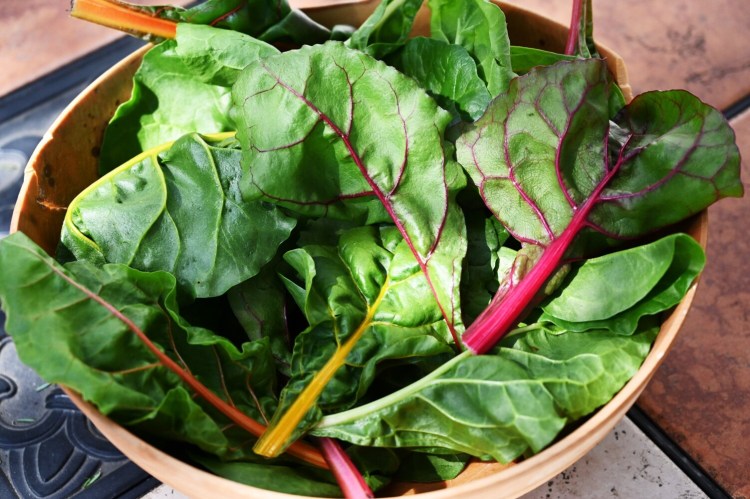My first interaction with Swiss chard was a long one. It was 1999 and, as a birthday gift, a friend had paid a large sum of money so she and I could be “prep cooks” for a day in an upscale restaurant called Anago, located in the Lenox Hotel in Boston. As part of the deal, we would sit down to a five-course meal we helped prepare. The chef forgot we were coming at 8 a.m. None of the real prep cooks wanted to assign us a task requiring any skill, so we spend several hours separating the leaves from the ribs of three cases of Swiss chard.
My first interaction with rainbow chard was an embarrassing one. It was 2011 and I was the brand-new manager of a farmers market in central Pennsylvania. I told a farmer I appreciated her efforts to assemble bunches of chard containing one stalk each of red, white, yellow, orange, pink and purple varieties. They were so pretty, I told her. Rainbow chard seed mixes grow that way, Christine, she told me, rolling her eyes at the notion that any farmer had the time to purposefully assemble a bouquet of greens as I had imagined.
Neither experience has soured me on Swiss chard. I love it. And I kind of feel sorry for chard. This cousin of the beet, which has many names including silverbeet, perpetual spinach, seakale beet and mangold but no bulbous root, has been wrongly sidelined by the prolonged kale craze. I have a right mind to create a custom T-shirt that says, “Keep Calm and Eat Chard.” Or maybe make a bumper sticker that reads, “Kale No, Chard Yes.”
Chard is as versatile, nutritious, and widely available as kale in Maine right now. But its leaves are milder and more tender. Its stalks are sweet and edible. And chard is much, much prettier. Chard can not only stand in for kale in most instances, its leaves can also be used in any recipe that calls for spinach.
Chard has been cultivated since at least the third century, reportedly originating in Sicily where it is still widely served sautéed with onions, raisins and pine nuts. Chard is also wilted into Italian soups, served as the main ingredients in pasta sauces and eaten raw in salads. “LaRousse Gastronomique,” a French culinary encyclopedia, tells me chard is used regionally to make everything from fritters called Farçous in Aveyron, to greens-laced meatballs called caillette in Lyon, to tourte de blettes in Nice, where it gets equal play with apples in a sweet tart.
Should your chard wilt on a hot summer ride home from the market, recharge it in a bowl of cold water for an hour or so. After soaking (or rinsing if the greens did not wilt on you), separate the smaller leaves from the larger ones. The former are best eaten raw but do so within a day or two of buying them as they will also age faster than larger older ones will. To store the latter, use a sharp paring knife to cut the leaves from the stems. Wrap both leaves and stems in a clean towel and store in the refrigerator for up to a week. Use the leaves like you would spinach and the stems like you would celery and soon you to will want to be sporting a T-shirt or a bumper sticker singing the praising of these pretty greens.
CHRISTINE BURNS RUDALEVIGE is a food writer, recipe developer and tester, and cooking teacher in Brunswick, and the author of “Green Plate Special,” a cookbook from Islandport based on these columns. She can be contacted at cburns1227@gmail.com.
Chard, Leek and Green Garlic Pasta
Serves 4
1/2 cup chopped walnuts
6 tablespoons olive oil
1 bunch Swiss chard, leaves separated from stems and chopped
1 leek, white and light green parts thinly sliced and washed
2 stalks green garlic, finely chopped
Salt and freshly ground black pepper
1 pound pasta
½ cup crumbled feta or goat cheese
Place walnuts and olive oil in a large skillet over medium high heat. Cook the walnuts until they start to turn a bit golden and use a slotted spoon to transfer to a flattened-out paper bag to drain.
Add the chopped chard stems, leeks and green garlic to the skillet and cook, stirring occasionally, until they are soft, about 12 minutes. Add the chard leaves, season with salt and pepper, and cook, stirring, until chard has wilted, about 5 minutes.
Meanwhile, cook pasta in a large pot of boiling salted water until al dente, 8-10 minutes depending on your type of pasta. Drain, reserving about 1/2 cup of the cooking water. Add the pasta and reserved cooking water to chard mixture. Stir in the cheese and reserved walnuts, adjust the seasoning, and serve.
Send questions/comments to the editors.




Comments are no longer available on this story